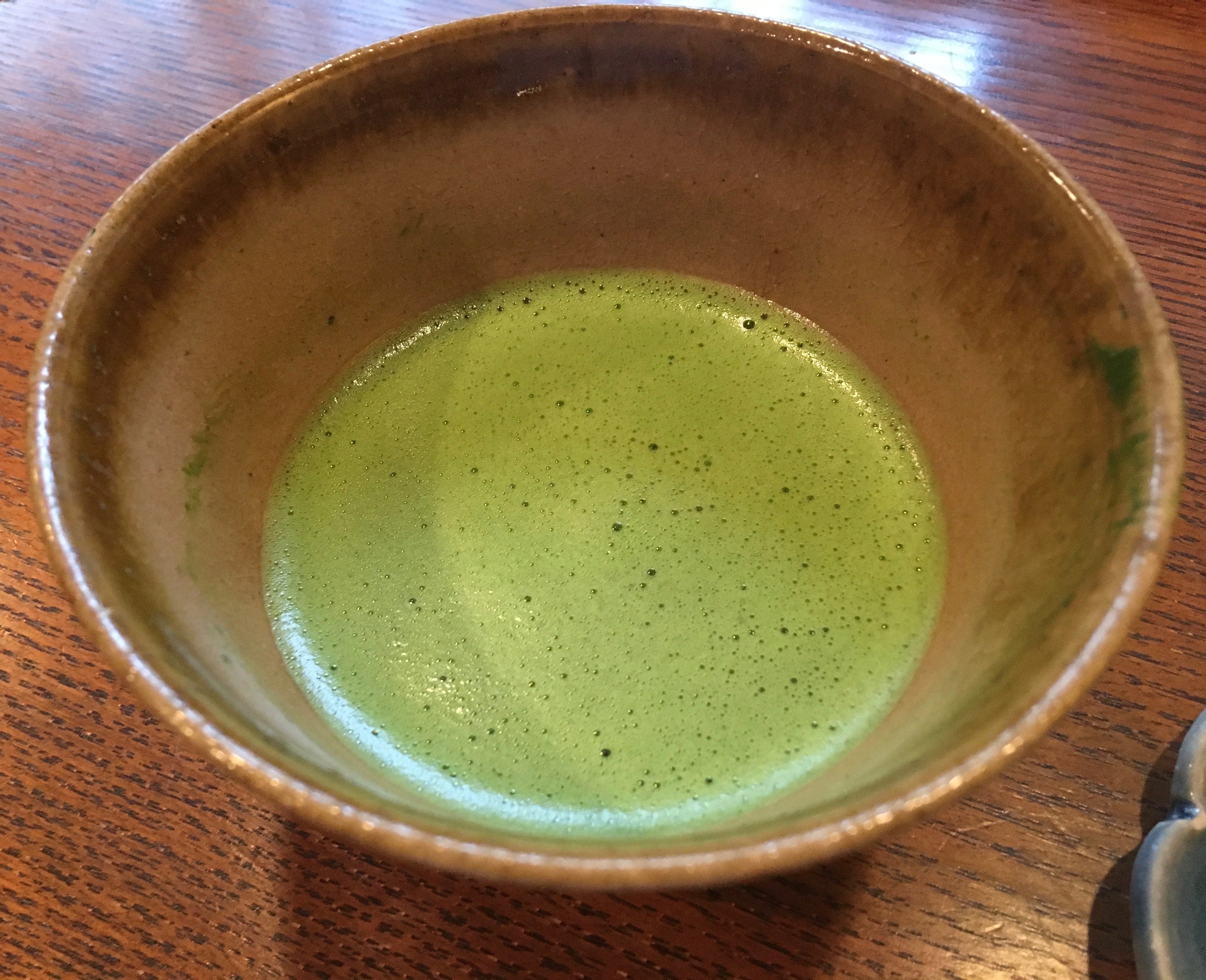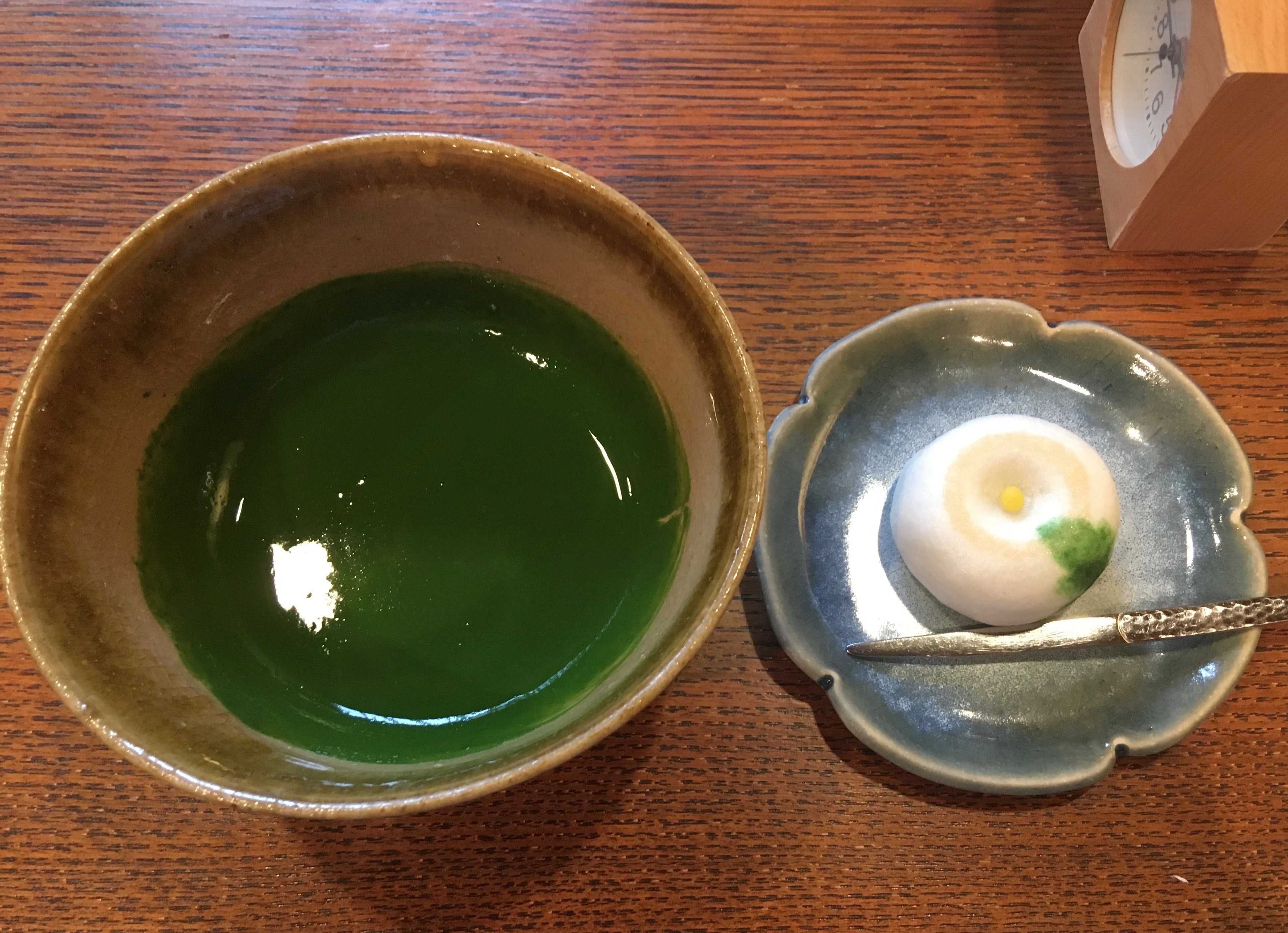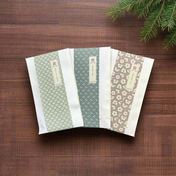Did you know that there are two ways of preparing matcha? Usucha and Koicha. Probably, the matcha you are familiar with looks like this:
 Usucha matcha served at Ippodo, Kyoto Prefecture, Japan. Photo by Jimmy Burridge.
Usucha matcha served at Ippodo, Kyoto Prefecture, Japan. Photo by Jimmy Burridge.
This is usucha, the more common type which people are usually familiar with. One would more commonly come across usucha in cafes in Japan, and it is often the one made/served in households. If you know a little bit of Japanese, the characters for koi (濃; thick) and usu (薄; thin) represent the degree of thickness of the matcha. That being said, koicha, or thick matcha is made with a higher matcha to water ratio and has a more impactful aroma and flavor.
For recap, matcha is typically high quality tea that has been shaded before harvest, processed by steaming, drying without rolling (most Japanese green teas are rolled), refined into flakes and then ground into a fine powder. The shading process reduces bitter-tasting catechin; therefore increasing the savory tasting theanine content in the leaf, creating matcha’s unique flavor profile.
Thick vs. Thin
The major difference between a usucha and koicha is thickness. While you may have previous experience drinking the usucha matcha (it’s quite smooth like tea, no?), if you have never tried a koicha, you may be surprised at how thick a koicha is! Indeed, koicha has a thickness that is almost like a thick soup, it is syrupy! The thickness is a result of having 2-3 times the amount of matcha and less water in comparison to a usucha. I remember the first time I tried a koicha, just the appearance of it made me think that it would be quite “shibui” (i.e., bitter in Japanese).
 Koicha matcha served at Ippodo, Kyoto Prefecture, Japan. Photo by Jimmy Burridge.
Koicha matcha served at Ippodo, Kyoto Prefecture, Japan. Photo by Jimmy Burridge.
However, with respect to flavor profile, the matcha typically used for a koicha will have more umami, sweetness and less bitterness. So, for me, it was quite an intense but pleasant experience especially with the wagashi (Japanese sweet) which balanced out the strength of the tea.
To elaborate a bit, it was as if I was transported to a dreamy mossy green world full of depth, an unknown yet strangely familiar magical realm. I could visualize moving through a scene from Princess Mononoke (Hayao Miyazaki’s film) with overlapping layers of vibrant green life, soft muffled sounds and thick moist air…

Mossy Friends in Oirase, Aomori Prefecture; photo by Moé Kishida.
For koicha, look for matcha powder that has the mukashi (昔) character
The matcha used for a koicha is sweeter, of higher quality and will be more expensive. In Japan, when one is looking for a matcha appropriate for a koicha, generally, we look for the character mukashi (昔). On the other hand, if you are looking for an usucha matcha, then look for the shiro (白) character. Of course, you can also obtain help from the person at the tea store. At least in Japan, and at the nicer tea shops internationally, they will know the difference between koicha and usucha and will be able to help!
You can even try this method on the Yunomi site! Search for “mukashi” and you will find matchas which are suitable for a koicha. It’s also possible to simply search for "koicha". In the matcha powder description, it will state whether it is suited for a koicha.
 Two matchas side by side from Shogyokuen Tea Factory (Kyotonabe, Kyoto Prefecture). Notice the character "昔" (mukashi) on the left for a koicha, and the kanji "白" (shiro) on the right for a usucha. Product photos from Yunomi.
Two matchas side by side from Shogyokuen Tea Factory (Kyotonabe, Kyoto Prefecture). Notice the character "昔" (mukashi) on the left for a koicha, and the kanji "白" (shiro) on the right for a usucha. Product photos from Yunomi.
Some matchas well-suited to make koicha from Yunomi:
- AOI Seicha: Nishio Matcha - Sunkou no Mukashi, Imperial Ceremonial Grade Koicha (30g, 4900yen)
- AOI Seicha: Nishio Matcha - Tenkei, Ceremonial Heritage Grade Koicha (30g, 10000yen)
- Nishide Tea Factory: Uji Matcha Chiyo Mukashi, Stone mill ground, Standard Ceremonial Grade (40g, 2300yen)
- Shogyokuen Tea Factory: Matcha Hatsu Mukashi, Imperial Ceremonial Grade, Spring Harvest 初昔 (40g, 3499yen)
The list is not exhaustive but you can see that these matchas are a bit more expensive in comparison to some of the others available through Yunomi. In general, in Japan, the matchas appropriate for a koicha will cost at least 2,000yen (approximately $18.00) per 40grams. For more information about matcha quality, please refer to Ian Chun’s article on: Yunomi Matcha Grades.
Kneading a koicha (No whisking!)
As noted earlier, when one makes a koicha, you use about double the amount of matcha as for an usucha. While the specific amount of tea and water can vary by tea school, in general 2g of matcha is used to make a usucha and 4g of matcha to make koicha. For koicha, one utilizes hot water of about 80 degrees Celsius (176 F), with approximately 40ml of hot water and the mixing action is referred to as: Matcha wo "neru"(抹茶をねる; we knead the matcha). The difference between kneading and whisking may seem subtle and in fact, years can be spent to learn the proper method, but you can also just intuit the difference.
As you can tell from the koicha photos, no bubbles are produced in the thick matcha. So, if a tea master isn’t watching and you would like to experiment, try using gentle strokes that invert the top and bottom layers of the matcha and water mix, without making bubbles. If you’re familiar with baking bread think about the stage where you fold the dough in a way that doesn’t break the gluten. With proper kneading, one will obtain a thick, smooth, syrup-like matcha.
This contrasts to the usucha preparation method in which one utilizes around 60ml of hot water at about 90 degrees Celsius (194F). The action used for making ushucha matcha is referred to as: Matcha wo “tateru” (抹茶を点てる - we whisk the matcha). The goal of this type of whisking is to produce a thick layer of small bubbles, but there are of course different matchas that inherently produce more or less bubbles, and the amount of bubbles alone is not an indicator of quality, nor of your skill!
Beyond Thickness and Quality
Lastly, there is also a difference when it comes to the matcha bowl used and how the matcha is enjoyed. For usucha, one usually selects a seasonally appropriate bowl. As you may know, demonstrating an awareness of the season by subtle cues in decoration, food or utensil pairings and even in conversation is part of high Japanese culture. Often usucha bowls are decorative with beautiful and/or colorful designs. In fact, in the usucha tea ceremonies, the custom is often to enjoy conversations related to the tea bowl. Thus, one can freely choose from different patterns, colors, and designs. In a usucha tea ceremony, if there is more than one guest, it is the case that each person is served one bowl of matcha.
On the other hand, to enjoy koicha, one utilizes a bowl that was made through raku-yaki, one of the most prestigious earthenware in the tea ceremony. A distinct characteristic of these types of bowls is that they are simple and without patterns. An educated observer will know they are made of a clay with specific density and an exclusive selection of glazes. They are potted by a method called “Tedukune” (手捏ね, hand kneading) and are made only with the hands and spatula, without the use of a potter’s wheel. More and formal, these raku-yaki bowls reflect the wabi taste of the great tea master, Sen-no-Rikyu. Lastly, in a koicha tea ceremony, the one bowl of koicha will be enjoyed by all of the guests (e.g., 3-5 guests). This way of enjoying matcha is to have been developed during the time of Sen-no-Rikyu.
Main Takeaways for Koicha and Usucha
 *Please note these are the distinct differences; however, if one studies the Japanese tea ceremony, there will be numerous other detailed differences in the actual tea ceremonies (e.g., here is an in-depth table of other differences).
*Please note these are the distinct differences; however, if one studies the Japanese tea ceremony, there will be numerous other detailed differences in the actual tea ceremonies (e.g., here is an in-depth table of other differences).
Inspired to try a koicha? While it may not be for everyone, it is an unique experience that all matcha lovers should experience at least once. Well, that’s just my opinion! Please note that usucha and koicha are individually complete demonstrations of hospitality, even while in some formal ceremonies an usucha follows a koicha. The two matchas have complementary presence in this formal presentation and become like yin and yang, sun and moon, fall and spring.
Feature image photo; Koicha matcha served at Ippodo, Tokyo, Japan. Photo by Jimmy Burridge



1 comment
I practice tea ceremony and Koicha to me is the essence of the tea ceremony.